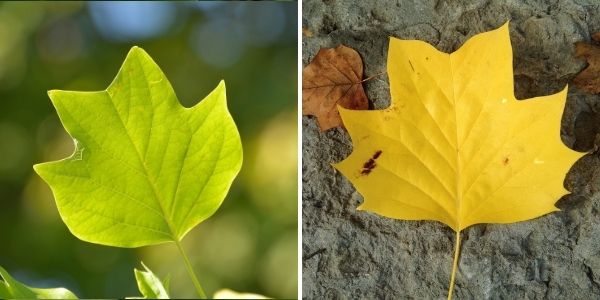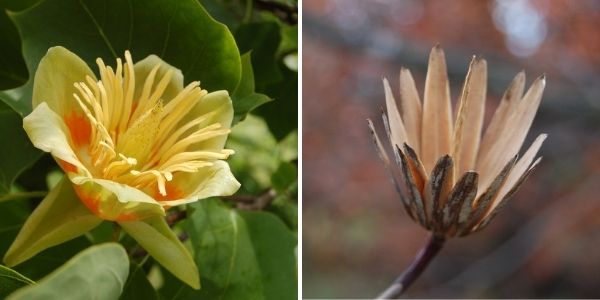Although commonly known as the tulip tree, yellow poplar or tulip poplar, the tulip tree is not actually closely related to poplar trees or tulips. It is a member of the Magnolia family, which is known for its many flowering plants. The botanical name Liriodendron tulipifera derives from Greek with the Genus Liriodendron meaning “lilytree” and the specific epithet, tulipifera, meaning “tulip bearing,” which is clearly inspired by the tulip-shaped flowers.
The tulip tree is shade-intolerant, preferring spaces that offer full sunlight (six or more hours per day) coupled with well drained sandy-loam soils. Highly regarded for being a fast-growing species (in the right conditions, of course), the main trunk of the tulip tree can reach an average height of about 50 feet at maturity. The bark is smooth and light grey when young but becomes ridged and grey brown as the tree matures. The light green leaves have four main lobes and a notched to flat top, giving them the distinct resemblance of tulip cups or a whale’s tail. In the fall, the leaves turn a magnificent yellow before dropping.

In the spring, yellow to pale green flowers begin to emerge. These flowers are cup shaped, resembling tulip flowers, with six petals and a flash of orange along their base. In most cases, it can take over 10 years after planting for the tulip tree to develop flowers – but it’s worth the wait! Summer and early fall give rise to the tree’s fruits, which are small, brown clusters of winged samaras (seeds) that fall when mature, leaving their sheath (casing) standing erect on branches into the winter months.

Although known for its uniquely beautiful features, the tulip tree also offers a wide range of benefits to both humans and wildlife. Trees that tend to grow quicker are often subject to having weak wood, but not the mighty tulip tree. Tulip tree wood is strong and versatile and has been used to make furniture or canoes. The seeds are an important food source often eaten by finches, rabbits, and squirrels, and the flower’s nectar offers a sweet treat for ruby-throated hummingbirds and other native wildlife.

The tulip tree is a perfect addition for larger, open yards that receive lots of sun. So, if you are looking for a tall growing shade tree with unique leaves and flowers, check out our Backyard Tree Planting Program and sign up for a consultation with one of our arborists today!
Jon Curtis is the Residential Planting Programs Field Coordinator at LEAF.
LEAF offers a subsidized Backyard Tree Planting Program for private property. The program is supported by the City of Toronto, the Regional Municipality of York, the City of Markham, the Town of Newmarket, the Regional Municipality of Durham, the Town of Ajax, the City of Pickering, the City of Oshawa, the Township of Scugog, the Town of Whitby, Ontario Power Generation, Ontario Trillium Foundation and GrandTrees/Canadian Trees For Life.
